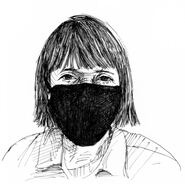Recent papers
We've been sharing what we've learned through ICTA. If you'd like to hear more, get in touch.
Wall, M. & Mauldin, B. (2023, February). Covid Conspiracy Lotería: Playing the Pandemic. A paper presented at the 42nd annual Southwest Popular/American Culture Association, Albuquerque, New Mexico.
Wall, M. & Mauldin, B. (2022, November). The Institute for Conspiracy Theory Analysis: An intervention into misinformation and conspiracy thinking. A paper presented at the 3rd International Conference on Communication and Media Studies, Tirana, Albania.
Wall, M. & Mauldin, B. (2022, February). There’s a COVID vaccine in your salad dressing! Teaching about conspiracy theories. A paper presented at the 41th annual Southwest Popular/American Culture Association, Albuquerque, New Mexico.
We've been sharing what we've learned through ICTA. If you'd like to hear more, get in touch.
Wall, M. & Mauldin, B. (2023, February). Covid Conspiracy Lotería: Playing the Pandemic. A paper presented at the 42nd annual Southwest Popular/American Culture Association, Albuquerque, New Mexico.
Wall, M. & Mauldin, B. (2022, November). The Institute for Conspiracy Theory Analysis: An intervention into misinformation and conspiracy thinking. A paper presented at the 3rd International Conference on Communication and Media Studies, Tirana, Albania.
Wall, M. & Mauldin, B. (2022, February). There’s a COVID vaccine in your salad dressing! Teaching about conspiracy theories. A paper presented at the 41th annual Southwest Popular/American Culture Association, Albuquerque, New Mexico.
ICTA was inspired in part by the Institute for Propaganda Analysis (1937-1942), an organization that defended democracy by promoting critical thinking.
About the Institute for Propaganda Analysis
The Institute for Propaganda Analysis (IPA) was initiated by journalists and educators in the 1930s at Columbia University in New York to counter the increasing use of undemocratic propaganda. Aiming to create “propaganda literacy,” the IPA produced one-page educational fliers, a regular bulletin that analyzed recent instances of propaganda and funded reports such as the classic study, “The Fine Art of Propaganda: A Study of Father Coughlin’s Speeches” by Alfred McClung Lee and Elisabeth Briant Lee (1).
The institute prepared manuals for study groups and schools, supplying teachers with tools to provide training in the analysis of propaganda. Because students were among IPA’s key audiences, the organization simplified its concepts into digestible lessons.(2) IPA also taught tolerance of diverse races and religions.(3) They are perhaps best known for identifying and popularizing the seven common propaganda techniques (e.g., “glittering generalities,” “bandwagon,” “plain folks,” etc.), which, for decades, appeared in mass communication textbooks.
As its founder Clyde Miller noted, “The Institute of Propaganda Analysis was organized to aid in the development of this art of thinking and discussing independently together.”(4)
Eventually, the IPA was considered too critical of existing communication structures and practices and thus was perceived by the powerful as dangerous. The House Committee on UnAmerican Activities (HUAC) targeted the organization for being part of an imagined plot to nurture subversive behavior and communism in America. (5) In the end, the Institute for Propaganda Analysis itself was a victim of a conspiracy theory.
The Institute for Propaganda Analysis (IPA) was initiated by journalists and educators in the 1930s at Columbia University in New York to counter the increasing use of undemocratic propaganda. Aiming to create “propaganda literacy,” the IPA produced one-page educational fliers, a regular bulletin that analyzed recent instances of propaganda and funded reports such as the classic study, “The Fine Art of Propaganda: A Study of Father Coughlin’s Speeches” by Alfred McClung Lee and Elisabeth Briant Lee (1).
The institute prepared manuals for study groups and schools, supplying teachers with tools to provide training in the analysis of propaganda. Because students were among IPA’s key audiences, the organization simplified its concepts into digestible lessons.(2) IPA also taught tolerance of diverse races and religions.(3) They are perhaps best known for identifying and popularizing the seven common propaganda techniques (e.g., “glittering generalities,” “bandwagon,” “plain folks,” etc.), which, for decades, appeared in mass communication textbooks.
As its founder Clyde Miller noted, “The Institute of Propaganda Analysis was organized to aid in the development of this art of thinking and discussing independently together.”(4)
Eventually, the IPA was considered too critical of existing communication structures and practices and thus was perceived by the powerful as dangerous. The House Committee on UnAmerican Activities (HUAC) targeted the organization for being part of an imagined plot to nurture subversive behavior and communism in America. (5) In the end, the Institute for Propaganda Analysis itself was a victim of a conspiracy theory.
Sources:
1. Fondren, E. (2021). “We are Propagandists for Democracy”: The Institute for Propaganda Analysis’ Pioneering Media Literacy Efforts to Fight Disinformation (1937–1942). American Journalism, 38(3), 258-291.
2. Hobbs, R. & McGee, S. (2014). Teaching about Propaganda: an examination of the historical roots of media literacy. Journal of Media Literacy Education 6(2), 56-67.
3. Schiffrin, A. (2018, Oct. 10). Fighting disinformation with media literacy—in 1939. Columbia Journalism Review. Retrieved from https://www.cjr.org/innovations/institute-propaganda-analysis.php
4. Miller, C. (1939). Forward. The Fine Art of Propaganda (pp. vii-x). New York: Institute of Propaganda Analysis. (p. viii)
5. Sproule, J. M. (1984). The Propaganda Analysis Movement since World War I. A Paper presented at the 70th Annual Meeting of the Speech Communication Association,Chicago, IL, November 1-4, 1984.
1. Fondren, E. (2021). “We are Propagandists for Democracy”: The Institute for Propaganda Analysis’ Pioneering Media Literacy Efforts to Fight Disinformation (1937–1942). American Journalism, 38(3), 258-291.
2. Hobbs, R. & McGee, S. (2014). Teaching about Propaganda: an examination of the historical roots of media literacy. Journal of Media Literacy Education 6(2), 56-67.
3. Schiffrin, A. (2018, Oct. 10). Fighting disinformation with media literacy—in 1939. Columbia Journalism Review. Retrieved from https://www.cjr.org/innovations/institute-propaganda-analysis.php
4. Miller, C. (1939). Forward. The Fine Art of Propaganda (pp. vii-x). New York: Institute of Propaganda Analysis. (p. viii)
5. Sproule, J. M. (1984). The Propaganda Analysis Movement since World War I. A Paper presented at the 70th Annual Meeting of the Speech Communication Association,Chicago, IL, November 1-4, 1984.


